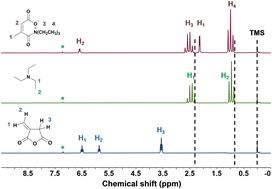Near-infrared emission of a novel nonconventional luminophore for in vitro imaging†
Abstract
Luminogens without recognizable luminophores are attracting increasing attention owing to their particular photophysical properties and outstanding biocompatibility features. Despite rapid advances, it is still a formidable challenge to synthesize nonconjugated fluorescent materials with efficient near-infrared emission. Unlike traditional organic luminescent materials with long-range conjugation, the limited degree of electron delocalization and large energy gap are not favorable for long-wavelength emission. Herein, we observed universal intrinsic fluorescence formed from the mixtures of itaconic anhydride (ITA) and electron-rich solvents/monomers. Further, triethylamine (TEA) could promote the ring opening of ITA and subsequently generated the zwitterionic compound (I-TEA). The photophysical properties of I-TEA showed that I-TEA had the typical characteristics of concentration enhanced emission (CEE), excitation-dependent emission (EDF), temperature-sensitive emission (TSE), and efficient red emissions (λex = 585 nm, QY = 12.63%). The cytotoxicity assay indicated that I-TEA had low toxicity for MC3T3-E1 cells and was suitable for cell imaging. In addition, the PL properties and emission source of the mixtures of ITA and electron-rich solvents (DMSO and DMF) were preliminary investigated by NMR, fluorescence, and UV-vis spectroscopy techniques and theoretical calculations. This study reveals the general intrinsic fluorescence from mixtures of ITA and electron-rich solvents or monomers and provides a strategy for preparing nonconventional luminophores with efficient long-wavelength emission.

- This article is part of the themed collection: 2023 Journal of Materials Chemistry C HOT Papers


 Please wait while we load your content...
Please wait while we load your content...